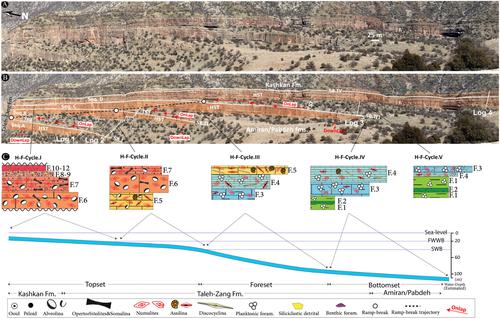当前位置:
X-MOL 学术
›
Basin Res.
›
论文详情
Our official English website, www.x-mol.net, welcomes your
feedback! (Note: you will need to create a separate account there.)
Lower Eocene carbonate ramp clinoforms of the southern Tethys; Zagros Foreland Basin, SW Iran: Sequence stratigraphy architecture, basin physiography and carbonate factory controlling parameters
Basin Research ( IF 2.8 ) Pub Date : 2023-06-25 , DOI: 10.1111/bre.12790
Mohammad Nikfard 1
Basin Research ( IF 2.8 ) Pub Date : 2023-06-25 , DOI: 10.1111/bre.12790
Mohammad Nikfard 1
Affiliation

|
Excellent cliff exposures in the Khush-Ab and Chenareh anticlines (Zagros Foreland Basin, SW Iran) offer a good opportunity to document stratal geometries, paleofacies heterogeneity, depositional architecture and depositional cycles of the Lower Eocene sedimentary basin system. These unique outcrops containing six logged sections have been studied across a large-scale transect, covering ca. 10 km of continental (Kashkan Formation), carbonate-dominated platforms (Taleh-Zang Formation) and submarine fan to basin-floor settings (Amiran and Pabdeh formations). Field observations of the bedding geometries revealed a set of NE–SW oriented carbonate ramp clinoforms (clinoformal units 1–4) with sigmoidal cross-sectional shapes and an internal fore-stepping architecture. Based on detailed facies analysis, six facies associations (FA) were identified (FA.I to FA.VI), which are interpreted to have been deposited laterally in the continental, proximal to distal and deep-water settings of a distally steepened carbonate ramp. According to the stratal stacking pattern, bounding surface, facies architecture and internal makeup of carbonate clinoforms, four H-F-cycles (cycle I–IV) corresponding to a lower hierarchical rank (fourth-order cycle) were recognized and nested within the regressive stacking pattern (HST) of a higher hierarchical rank (third-order sequence). These H-F-cycles are arranged in three segments (bottomset, foreset and topset) of each clinoformal unit. Higher rank transgressive blocks (TST) discriminated each clinoformal unit by up-deepening sets of the H-F-cycle V. In total, five third-order depositional sequences were identified. The sequence, stratigraphic framework and internal makeup of this carbonate platform indicate that these carbonate sloping successions are the type of accretionary carbonate ramp clinoforms that display an ascending ramp-slope break trajectory. Evolutionary episodes of biogenic communities, climatic change, local tectonic movements, physical processes (e.g. waves and storms) and water depth gradient are major forcing parameters that controlled the carbonate factory and depositional geometry of this Lower Eocene succession; however, carbonate-producing organisms and eustatic sea-level fluctuations played the first role, and local tectonic movements in response to tectonic activities of the Zagros Foreland Basin played the second role. As a result, Taleh-Zang carbonate platforms are rich in diverse assemblages of LBFs without fragments of coral and red algae, which appear to be a consequence of a hothouse state that diminishes the global thermal gradient, weakens pycnoclines and thereby limits the turbulence.
中文翻译:

特提斯南部始新世下始新世碳酸盐坡坡斜形;伊朗西南部扎格罗斯前陆盆地:层序地层结构、盆地地貌和碳酸盐工厂控制参数
Khush-Ab 和 Chenareh 背斜(伊朗西南部扎格罗斯前陆盆地)的绝佳悬崖暴露为记录下始新世沉积盆地系统的地层几何形状、古相异质性、沉积结构和沉积旋回提供了良好的机会。这些独特的露头包含六个伐木部分,已在大规模样带上进行了研究,覆盖约。10 公里长的大陆(卡什坎组)、碳酸盐岩为主的台地(Taleh-Zang 组)和海底扇到盆地底部的环境(Amiran 和 Pabdeh 组)。对层理几何形状的现场观察揭示了一组 NE-SW 取向的碳酸盐坡道斜形(斜形单元 1-4),具有 S 形横截面形状和内部前阶结构。根据详细的相分析,确定了六个相组合(FA)(FA.I 至 FA.VI),这些相组合被解释为横向沉积在大陆、近端和远端陡峭碳酸盐坡道的深水环境中。根据碳酸盐斜状的地层堆积模式、界面、相结构和内部组成,对应于较低等级(四级旋回)的四个HF旋回(旋回I-IV)被识别并嵌套在回归堆积模式中(HST) 具有更高的层次等级(三阶序列)。这些 HF 循环排列在每个斜形单元的三段(底组、前组和顶组)中。较高等级的海侵块体 (TST) 通过向上加深的 HF-旋回 V 组来区分每个斜形单元。总共确定了 5 个三级沉积序列。该碳酸盐台地的层序、地层格架和内部构成表明,这些碳酸盐岩倾斜层序是增生碳酸盐坡道斜坡类型的类型,显示出上升的坡道-坡折轨迹。生物群落的演化事件、气候变化、局部构造运动、物理过程(例如波浪和风暴)和水深梯度是控制碳酸盐工厂和下始新世序列的沉积几何形状的主要强迫参数;然而,产生碳酸盐的生物和海平面升降起着第一个作用,而响应扎格罗斯前陆盆地构造活动的局部构造运动则起着第二个作用。因此,Taleh-Zang 碳酸盐台地富含多种 LBF 组合,没有珊瑚和红藻碎片,这似乎是温室状态的结果,温室状态减少了全球热梯度,削弱了密斜层,从而限制了湍流。
更新日期:2023-06-25
中文翻译:

特提斯南部始新世下始新世碳酸盐坡坡斜形;伊朗西南部扎格罗斯前陆盆地:层序地层结构、盆地地貌和碳酸盐工厂控制参数
Khush-Ab 和 Chenareh 背斜(伊朗西南部扎格罗斯前陆盆地)的绝佳悬崖暴露为记录下始新世沉积盆地系统的地层几何形状、古相异质性、沉积结构和沉积旋回提供了良好的机会。这些独特的露头包含六个伐木部分,已在大规模样带上进行了研究,覆盖约。10 公里长的大陆(卡什坎组)、碳酸盐岩为主的台地(Taleh-Zang 组)和海底扇到盆地底部的环境(Amiran 和 Pabdeh 组)。对层理几何形状的现场观察揭示了一组 NE-SW 取向的碳酸盐坡道斜形(斜形单元 1-4),具有 S 形横截面形状和内部前阶结构。根据详细的相分析,确定了六个相组合(FA)(FA.I 至 FA.VI),这些相组合被解释为横向沉积在大陆、近端和远端陡峭碳酸盐坡道的深水环境中。根据碳酸盐斜状的地层堆积模式、界面、相结构和内部组成,对应于较低等级(四级旋回)的四个HF旋回(旋回I-IV)被识别并嵌套在回归堆积模式中(HST) 具有更高的层次等级(三阶序列)。这些 HF 循环排列在每个斜形单元的三段(底组、前组和顶组)中。较高等级的海侵块体 (TST) 通过向上加深的 HF-旋回 V 组来区分每个斜形单元。总共确定了 5 个三级沉积序列。该碳酸盐台地的层序、地层格架和内部构成表明,这些碳酸盐岩倾斜层序是增生碳酸盐坡道斜坡类型的类型,显示出上升的坡道-坡折轨迹。生物群落的演化事件、气候变化、局部构造运动、物理过程(例如波浪和风暴)和水深梯度是控制碳酸盐工厂和下始新世序列的沉积几何形状的主要强迫参数;然而,产生碳酸盐的生物和海平面升降起着第一个作用,而响应扎格罗斯前陆盆地构造活动的局部构造运动则起着第二个作用。因此,Taleh-Zang 碳酸盐台地富含多种 LBF 组合,没有珊瑚和红藻碎片,这似乎是温室状态的结果,温室状态减少了全球热梯度,削弱了密斜层,从而限制了湍流。

































 京公网安备 11010802027423号
京公网安备 11010802027423号